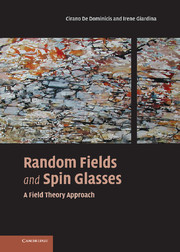Book contents
- Frontmatter
- Contents
- Preface
- List of abbreviations
- 1 A brief introduction
- 2 The Random Field Ising Model
- 3 The dynamical approach
- 4 The p = 2 spherical model
- 5 Mean field spin glasses: one-step RSB
- 6 The Sherrington–Kirkpatrick Model
- 7 Mean field via TAP equations
- 8 Spin glass above D = 6
- 9 Propagators, mostly replicon
- 10 Ward–Takahashi Identities and Goldstone modes
- 11 Alternative approaches and conclusions
- Appendix A Renormalization at one loop: ϕ4 theory (pure Ising)
- Appendix B Renormalization at one loop: tr ϕ3 theory (spin glass)
- Index
10 - Ward–Takahashi Identities and Goldstone modes
Published online by Cambridge University Press: 21 October 2009
- Frontmatter
- Contents
- Preface
- List of abbreviations
- 1 A brief introduction
- 2 The Random Field Ising Model
- 3 The dynamical approach
- 4 The p = 2 spherical model
- 5 Mean field spin glasses: one-step RSB
- 6 The Sherrington–Kirkpatrick Model
- 7 Mean field via TAP equations
- 8 Spin glass above D = 6
- 9 Propagators, mostly replicon
- 10 Ward–Takahashi Identities and Goldstone modes
- 11 Alternative approaches and conclusions
- Appendix A Renormalization at one loop: ϕ4 theory (pure Ising)
- Appendix B Renormalization at one loop: tr ϕ3 theory (spin glass)
- Index
Summary
In the previous chapter we have explicitly computed components of the (bare) propagators in the replicon sector and found that we had a spectrum of masses bounded below by zero modes. In this chapter we show that these massless modes are indeed Goldstone modes related to the spontaneous breaking of a continuous symmetry of the Lagrangian, and thus are to remain massless under loop corrections. We have already analyzed a case of spontaneous symmetry breaking in the different context of the TAP free energy in Chapter 7. Here, we focus on the invariance properties of the spin glass Lagrangian and exhibit the continuous symmetry spontaneously broken below the AT line, which entails corresponding Ward–Takahashi Identities. We start in Section 10.1 by describing the problem in the simpler setting of a system with a two-component order parameter. In Section 10.2 we generalize to the spin glass case, by defining the symmetry which undergoes spontaneous breaking. In Section 10.4 we give a derivation of the Ward–Takahashi Identities, expressing the fact that the massless transverse modes are indeed Goldstone modes. Details of what follows can be found in De Dominicis, Kondor and Temesvari (1998).
The Legendre Transform and invariance properties
To explain the general problem we would like to address, it is convenient to consider first the case of a simpler field theory (at least for what concerns the notation).
- Type
- Chapter
- Information
- Random Fields and Spin GlassesA Field Theory Approach, pp. 183 - 192Publisher: Cambridge University PressPrint publication year: 2006



